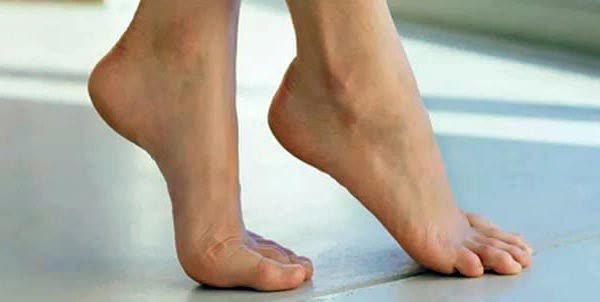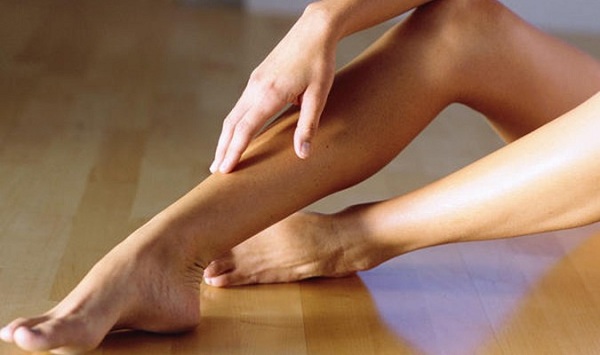
Woman Persistently Stands on Tiptoes for 10 Minutes Every Day: After Half a Year, Insomnia Is Eliminated, 3 Other Diseases Also Improve

A Woman Stands on Tiptoes for Half a Year to Improve Her Sleep
Mrs. Wang, 54 years old, has always paid attention to her health. Thanks to that, despite her age, her body remains in relatively good condition. However, some time ago, she began suffering from insomnia. Although she tried several methods, the results were not very effective.
One day, while chatting with a friend at the market, Mrs. Wang mentioned her insomnia. Her friend suggested she try standing on tiptoes to sleep better.
Intrigued, Mrs. Wang decided to give it a try. Back home, she searched for the correct way to practice tiptoe walking. Whether shopping or taking a walk, she made sure to persist with tiptoe movements. Even before going to bed, she would practice standing on her toes while in bed. At first, her family did not understand her actions. But after half a year, when they saw the positive changes in her, they became very supportive.
Initially, Mrs. Wang practiced tiptoeing mainly to improve her sleep disorder. After just two weeks, her insomnia had improved, and she was able to fall asleep quickly after lying down. According to doctors, standing on tiptoes helps relieve body pressure, promotes blood circulation, and makes it easier to fall into a deep, restful sleep. Practicing for 10 minutes a day can safely and effectively improve sleep quality.
After six months of tiptoe exercises, Mrs. Wang not only improved her sleep but also experienced other positive health changes:
1. Relief from constipation
Previously, Mrs. Wang often had mild constipation. After six months of tiptoe practice, her condition improved.
In fact, tiptoeing can help with constipation, which makes sense. Constipation is mainly caused by slow intestinal movement and a lack of dietary fiber. Tiptoe walking stimulates the calf muscles, promoting blood circulation and improving blood flow to the digestive tract, which helps relieve constipation.
2. Improved heart function
Before, Mrs. Wang occasionally felt chest tightness and shortness of breath after slight exertion. After six months of tiptoe training, her heart function improved, and those symptoms became far less noticeable.
In fact, when a person stands on tiptoes, the contraction of the leg muscles stimulates the blood vessels and pushes peripheral blood back to the heart. Over time, this strengthens heart function. At the same time, tiptoeing can raise the heart rate up to 150 beats per minute, and this temporary increase also exercises the heart.
3. Relief from hemorrhoids
Hemorrhoids are quite common today, especially internal hemorrhoids. Mrs. Wang also suffered from hemorrhoids, though her symptoms were mild, so she did not pay much attention. In the past, even a slightly spicy meal would worsen her condition. But since practicing tiptoe walking, her symptoms have greatly reduced.
The reason is that tiptoeing engages the abdominal muscles and lifts the anus, improving blood circulation in that area and thereby reducing hemorrhoid symptoms.
Does tiptoeing damage the knees?
Many people practice tiptoe walking daily because of its health benefits. However, after some time, they may experience knee pain or injury. In fact, even when done correctly, tiptoe exercises can still stress the knees.
This is because prolonged tiptoe standing shifts lower body weight forward, compressing the knee joints and potentially damaging the meniscus. Therefore, each session should not be too long. It’s recommended to divide practice into four sets of about 25 tiptoe raises each, resting a few minutes in between.
To perform the exercise correctly, keep your body upright, feet together, lean slightly forward, and slowly lift your heels. Flat shoes or non-slip shoes are recommended.
Although tiptoeing has many benefits, it is not suitable for everyone. Older adults often have poor balance. Standing on tiptoes requires stability; otherwise, falls and fractures can occur, which are particularly dangerous in old age. For this group, aerobic exercises such as walking, brisk walking, jogging, or tai chi are more appropriate. Among these, walking is the safest and easiest, making it most suitable for the elderly.
News in the same category


Pay attention: if these 3 signs appear nightly before bed, it might signal that cancer cells are developing in your body

5 warning signs that can.cer may be coming but few people notice

4 bedtime secrets that will keep you healthier than supplements

7 Warning Signs of Can.cer

"3 Types of Tofu I Wouldn’t Eat Even If You Paid Me Extra”

5 Dangerous Signs Warning of Bone Cancer – Recognize It Early!

Don’t take nail-biting lightly — it may be linked to these dangerous conditions

5 silent warnings your body gives months before a heart at.tack

6 early warning signs of stage 1 colon can.cer you shouldn’t ignore

You will be surprised by the amazing health benefits of this tuber

People over 40 should practice these 3 morning habits immediately to avoid stroke

This morning symptom should never be ignored: it may signal cancer, seek medical attention immediately

Just one glass of sugarcane juice, taken at the perfect time, can unlock countless benefits for your body

7-year-old boy mo.cked by classmates for bad smell, mother stunned by what doctor removed from his mouth

Signs and treatment of early stage nasopharyngeal cancer

4 Oral Abnormalities That Are EARLY WARNINGS When Can.cer Targets You as Its “Prey”

Peeing in the shower: harmless habit or hidden danger? Experts explain

5 Early Signs of Lung C.an.cer You Need to Know
News Post

How to distinguish between poi.sonous and non-poi.sonous snakes

Foods that are toxic if eaten raw: what you need to know to protect your health

Pay attention: if these 3 signs appear nightly before bed, it might signal that cancer cells are developing in your body

5 warning signs that can.cer may be coming but few people notice

4 bedtime secrets that will keep you healthier than supplements

Simple and Effective Trick to Repel Mice with Leftover Rice – Anyone Can Do It

7 Warning Signs of Can.cer

Okra Has Many Benefits, Yet These 4 Groups of People Shouldn’t Eat It

"3 Types of Tofu I Wouldn’t Eat Even If You Paid Me Extra”

5 Dangerous Signs Warning of Bone Cancer – Recognize It Early!

Don’t take nail-biting lightly — it may be linked to these dangerous conditions

5 silent warnings your body gives months before a heart at.tack

6 early warning signs of stage 1 colon can.cer you shouldn’t ignore

You will be surprised by the amazing health benefits of this tuber

People over 40 should practice these 3 morning habits immediately to avoid stroke

The mystery behind flight attendants and bananas on flights — the answer will shock you

This morning symptom should never be ignored: it may signal cancer, seek medical attention immediately

Just one glass of sugarcane juice, taken at the perfect time, can unlock countless benefits for your body


